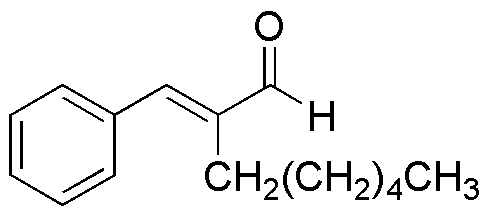a-Hexylcinnamaldehyde is widely utilized in research focused on:
- Fragrance Industry: This compound is a key ingredient in perfumes and scented products, providing a sweet, floral aroma that enhances the overall fragrance profile.
- Flavoring Agent: It is used in food products to impart a pleasant flavor, particularly in baked goods and confections, making them more appealing to consumers.
- Cosmetics: Commonly found in skincare and cosmetic formulations, it acts as a fragrance component, improving the sensory experience of products like lotions and creams.
- Research Applications: In scientific studies, it serves as a model compound for investigating the properties of aldehydes and their reactions, aiding in the development of new synthetic pathways.
- Insect Repellents: It has been explored for its potential use in natural insect repellents, offering an alternative to synthetic chemicals while providing effective pest control.
General Information
Properties
Safety and Regulations
Applications
a-Hexylcinnamaldehyde is widely utilized in research focused on:
- Fragrance Industry: This compound is a key ingredient in perfumes and scented products, providing a sweet, floral aroma that enhances the overall fragrance profile.
- Flavoring Agent: It is used in food products to impart a pleasant flavor, particularly in baked goods and confections, making them more appealing to consumers.
- Cosmetics: Commonly found in skincare and cosmetic formulations, it acts as a fragrance component, improving the sensory experience of products like lotions and creams.
- Research Applications: In scientific studies, it serves as a model compound for investigating the properties of aldehydes and their reactions, aiding in the development of new synthetic pathways.
- Insect Repellents: It has been explored for its potential use in natural insect repellents, offering an alternative to synthetic chemicals while providing effective pest control.
Documents
Safety Data Sheets (SDS)
The SDS provides comprehensive safety information on handling, storage, and disposal of the product.
Product Specification (PS)
The PS provides a comprehensive breakdown of the product’s properties, including chemical composition, physical state, purity, and storage requirements. It also details acceptable quality ranges and the product's intended applications.
Certificates of Analysis (COA)
Search for Certificates of Analysis (COA) by entering the products Lot Number. Lot and Batch Numbers can be found on a product’s label following the words ‘Lot’ or ‘Batch’.
*Catalog Number
*Lot Number
Certificates Of Origin (COO)
This COO confirms the country where the product was manufactured, and also details the materials and components used in it and whether it is derived from natural, synthetic, or other specific sources. This certificate may be required for customs, trade, and regulatory compliance.
*Catalog Number
*Lot Number
Safety Data Sheets (SDS)
The SDS provides comprehensive safety information on handling, storage, and disposal of the product.
DownloadProduct Specification (PS)
The PS provides a comprehensive breakdown of the product’s properties, including chemical composition, physical state, purity, and storage requirements. It also details acceptable quality ranges and the product's intended applications.
DownloadCertificates of Analysis (COA)
Search for Certificates of Analysis (COA) by entering the products Lot Number. Lot and Batch Numbers can be found on a product’s label following the words ‘Lot’ or ‘Batch’.
*Catalog Number
*Lot Number
Certificates Of Origin (COO)
This COO confirms the country where the product was manufactured, and also details the materials and components used in it and whether it is derived from natural, synthetic, or other specific sources. This certificate may be required for customs, trade, and regulatory compliance.

